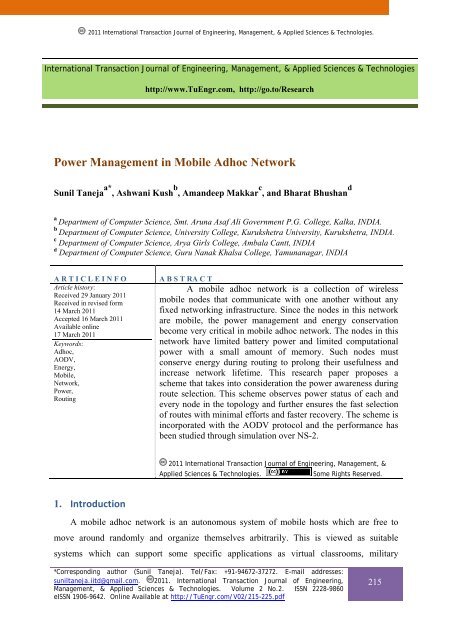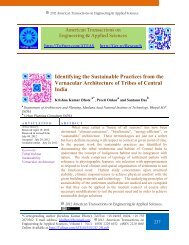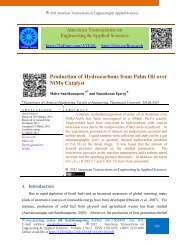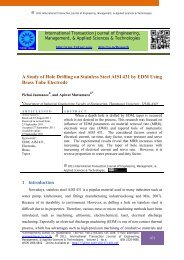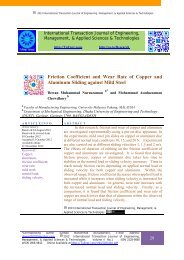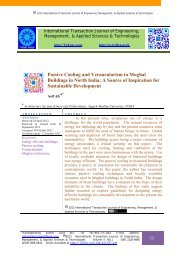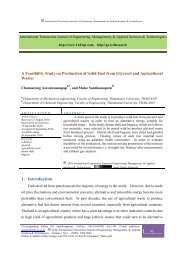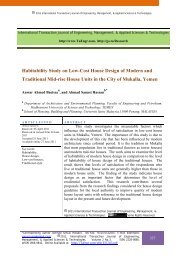Power Management in Mobile Adhoc Network - International ...
Power Management in Mobile Adhoc Network - International ...
Power Management in Mobile Adhoc Network - International ...
Create successful ePaper yourself
Turn your PDF publications into a flip-book with our unique Google optimized e-Paper software.
2011<br />
2011<br />
<strong>International</strong><br />
<strong>International</strong><br />
Transaction<br />
Transaction<br />
Journal<br />
Journal<br />
of<br />
of<br />
Eng<strong>in</strong>eer<strong>in</strong>g,<br />
Eng<strong>in</strong>eer<strong>in</strong>g,<br />
<strong>Management</strong>,<br />
<strong>Management</strong>,<br />
&<br />
Applied<br />
Applied<br />
Sciences<br />
Sciences<br />
&<br />
Technologies.<br />
Technologies.<br />
<strong>International</strong> Transaction Journal of Eng<strong>in</strong>eer<strong>in</strong>g, <strong>Management</strong>, & Applied Sciences & Technologies<br />
http://www.TuEngr.com, http://go.to/Research<br />
<strong>Power</strong> <strong>Management</strong> <strong>in</strong> <strong>Mobile</strong> <strong>Adhoc</strong> <strong>Network</strong><br />
Sunil Taneja a* , Ashwani Kush b , Amandeep Makkar c , and Bharat Bhushan d<br />
a Department of Computer Science, Smt. Aruna Asaf Ali Government P.G. College, Kalka, INDIA.<br />
b Department of Computer Science, University College, Kurukshetra University, Kurukshetra, INDIA.<br />
c Department of Computer Science, Arya Girls College, Ambala Cantt, INDIA<br />
d Department of Computer Science, Guru Nanak Khalsa College, Yamunanagar, INDIA<br />
A R T I C L E I N F O<br />
Article history:<br />
Received 29 January 2011<br />
Received <strong>in</strong> revised form<br />
14 March 2011<br />
Accepted 16 March 2011<br />
Available onl<strong>in</strong>e<br />
17 March 2011<br />
Keywords:<br />
<strong>Adhoc</strong>,<br />
AODV,<br />
Energy,<br />
<strong>Mobile</strong>,<br />
<strong>Network</strong>,<br />
<strong>Power</strong>,<br />
Rout<strong>in</strong>g<br />
1. Introduction<br />
A B S T RA C T<br />
A mobile adhoc network is a collection of wireless<br />
mobile nodes that communicate with one another without any<br />
fixed network<strong>in</strong>g <strong>in</strong>frastructure. S<strong>in</strong>ce the nodes <strong>in</strong> this network<br />
are mobile, the power management and energy conservation<br />
become very critical <strong>in</strong> mobile adhoc network. The nodes <strong>in</strong> this<br />
network have limited battery power and limited computational<br />
power with a small amount of memory. Such nodes must<br />
conserve energy dur<strong>in</strong>g rout<strong>in</strong>g to prolong their usefulness and<br />
<strong>in</strong>crease network lifetime. This research paper proposes a<br />
scheme that takes <strong>in</strong>to consideration the power awareness dur<strong>in</strong>g<br />
route selection. This scheme observes power status of each and<br />
every node <strong>in</strong> the topology and further ensures the fast selection<br />
of routes with m<strong>in</strong>imal efforts and faster recovery. The scheme is<br />
<strong>in</strong>corporated with the AODV protocol and the performance has<br />
been studied through simulation over NS-2.<br />
2011 <strong>International</strong> Transaction Journal of Eng<strong>in</strong>eer<strong>in</strong>g, <strong>Management</strong>, &<br />
Applied Sciences & Technologies. Some Rights Reserved.<br />
A mobile adhoc network is an autonomous system of mobile hosts which are free to<br />
move around randomly and organize themselves arbitrarily. This is viewed as suitable<br />
systems which can support some specific applications as virtual classrooms, military<br />
*Correspond<strong>in</strong>g author (Sunil Taneja). Tel/Fax: +91-94672-37272. E-mail addresses:<br />
suniltaneja.iitd@gmail.com. 2011. <strong>International</strong> Transaction Journal of Eng<strong>in</strong>eer<strong>in</strong>g,<br />
<strong>Management</strong>, & Applied Sciences & Technologies. Volume 2 No.2. ISSN 2228-9860<br />
eISSN 1906-9642. Onl<strong>in</strong>e Available at http://TuEngr.com/V02/215-225.pdf<br />
215
communications, emergency search and rescue operations, data acquisition <strong>in</strong> hostile<br />
environments, communications set up <strong>in</strong> exhibitions, conferences and meet<strong>in</strong>gs, <strong>in</strong> battle field<br />
among soldiers to coord<strong>in</strong>ate defense or attack, at airport term<strong>in</strong>als for workers to share files<br />
etc. In adhoc networks, nodes can change position quite frequently. The nodes <strong>in</strong> an adhoc<br />
network can be laptops, PDA or palm tops etc. These are often limited <strong>in</strong> resources such as<br />
CPU capacity, storage capacity, battery power and bandwidth. Each node participat<strong>in</strong>g <strong>in</strong> the<br />
network acts both as a router and as a host and must therefore be will<strong>in</strong>g to transfer packets to<br />
other nodes. For this purpose, a rout<strong>in</strong>g protocol should try to m<strong>in</strong>imize control traffic. There<br />
is limitation of battery life and <strong>in</strong> an adhoc environment, battery is most commonly used. The<br />
concept of power as one of the decid<strong>in</strong>g factor <strong>in</strong> route selection can be crucial <strong>in</strong> root<br />
discovery and root repair phase. Rest of the paper is organized as follows. Section 2 illustrates<br />
the power related issues of rout<strong>in</strong>g protocols <strong>in</strong> mobile adhoc network. New protocol<br />
description and system methodology is presented <strong>in</strong> section 3. Performance evaluation of new<br />
protocol us<strong>in</strong>g network simulator NS-2 is presented <strong>in</strong> section 4 and conclusion with future<br />
scope is given <strong>in</strong> section 5.<br />
2. Issues and Related Work<br />
The lack of a centralized authority complicates the problem of Medium Access Control<br />
(MAC) <strong>in</strong> mobile adhoc networks. The medium access regulation procedures have to be<br />
enforced <strong>in</strong> a distributed and hence collaborative fashion by mobile nodes. In the shared<br />
broadcast medium transmission of packets from dist<strong>in</strong>ct mobile nodes are prone to collision.<br />
This contention based medium access results <strong>in</strong> retransmissions and appreciable delays. The<br />
performance of the MAC scheme affects the rout<strong>in</strong>g protocol adversely and consequently the<br />
energy consumption for packet transmission and reception <strong>in</strong>creases.<br />
On-demand rout<strong>in</strong>g is composed of route discovery and route ma<strong>in</strong>tenance (Royer E. M.<br />
and Toh C. K., 1999). In route discovery, a source uses flood<strong>in</strong>g to f<strong>in</strong>d a route to its<br />
dest<strong>in</strong>ation. The large number of packets generated by flood<strong>in</strong>g consumes energy of nodes<br />
unnecessarily. The transit nodes, upon receiv<strong>in</strong>g a query, learn the path to the source and enter<br />
the route <strong>in</strong> their forward<strong>in</strong>g tables. The dest<strong>in</strong>ation node responds us<strong>in</strong>g the path traversed by<br />
the query. Route ma<strong>in</strong>tenance is responsible for react<strong>in</strong>g to topological changes <strong>in</strong> the<br />
network, and its implementation differs from one algorithm to the other. On-demand<br />
protocols <strong>in</strong>clude schemes like <strong>Adhoc</strong> On-demand Distance Vector rout<strong>in</strong>g (AODV) ( Perk<strong>in</strong>s<br />
216 Sunil Taneja, Ashwani Kush, Amandeep Makkar, and Bharat Bhushan
and Royer, 1999) and Dynamic Source Rout<strong>in</strong>g (DSR) (Johnson and Maltz, 1996). In these<br />
protocols, route discovery and ma<strong>in</strong>tenance may become <strong>in</strong>efficient under heavy network load<br />
s<strong>in</strong>ce <strong>in</strong>termediate nodes will have a higher probability of mov<strong>in</strong>g due to the delay <strong>in</strong> packet<br />
transmissions attributed to MAC contention. Routes have a higher probability of break<strong>in</strong>g as a<br />
result of mobility. The rediscovery or repair of routes wastes battery power. The flood<strong>in</strong>g of<br />
route request and route reply packets <strong>in</strong> on-demand rout<strong>in</strong>g protocols may result <strong>in</strong><br />
considerable energy dra<strong>in</strong>. Every station that hears the route request broadcasts will consume<br />
an amount of energy proportional to the size of the broadcast packet. In addition, stations that<br />
hear a corrupted version of a broadcast packet will still consume some amount of energy. In a<br />
multi-hop adhoc network, nodes must always be ready and will<strong>in</strong>g to receive traffic from their<br />
neighbors. All the nodes unnecessarily consume power due to reception of the transmissions<br />
of their neighbors. This wastes an extensive amount of the total consumed energy throughout<br />
the lifetime of a node.<br />
Many researchers (Taneja et al., 2010; Kuo-Q<strong>in</strong> Yan et al., 2009; Chen Jie et al., 2007;<br />
Joshi and Rege, 2007; Nie Nie and Comaniciu, 2006; J<strong>in</strong>-Man Kim and Jong-Wook Jang,<br />
2006; Woo et al., 1998; Chang J. H. and Tassiulas L., 2000) have carried out lot of research<br />
work related to energy sav<strong>in</strong>g by optimiz<strong>in</strong>g the use of battery power dur<strong>in</strong>g rout<strong>in</strong>g over<br />
mobile adhoc network through different k<strong>in</strong>ds of tools and techniques. Their research work<br />
has been taken <strong>in</strong>to consideration. The design objectives require select<strong>in</strong>g energy-efficient<br />
routes and m<strong>in</strong>imiz<strong>in</strong>g the control messag<strong>in</strong>g <strong>in</strong> acquir<strong>in</strong>g the route <strong>in</strong>formation. Efficient<br />
battery management (Chiasser<strong>in</strong>i et al., 2002; Adamou and Sarkar, 2002), transmission power<br />
management (Kawadia and Kumar , 2003; Toh, 2001) and system power management (Zheng<br />
and Kravets , 2003; S<strong>in</strong>gh and Raghavendra, 1998) are the major means of <strong>in</strong>creas<strong>in</strong>g the life<br />
of a node. These management schemes deal <strong>in</strong> the management of energy resources by<br />
controll<strong>in</strong>g the early depletion of the battery, adjust the transmission power to decide the<br />
proper power level of a node and <strong>in</strong>corporate low power consumption strategies <strong>in</strong>to the<br />
protocols. Typical metrics used to evaluate adhoc rout<strong>in</strong>g protocols are packet delivery ratio,<br />
average end to end delay, throughput, normalized rout<strong>in</strong>g load, and shortest hop etc.<br />
Recent developments related to energy on AODV protocol have been taken <strong>in</strong>to<br />
consideration. AODV is an improvement on DSDV which aims at reduc<strong>in</strong>g system wide<br />
broadcasts. In this protocol routes are discovered on-demand basis and ma<strong>in</strong>ta<strong>in</strong> these routes<br />
*Correspond<strong>in</strong>g author (Sunil Taneja). Tel/Fax: +91-94672-37272. E-mail addresses:<br />
suniltaneja.iitd@gmail.com. 2011. <strong>International</strong> Transaction Journal of Eng<strong>in</strong>eer<strong>in</strong>g,<br />
<strong>Management</strong>, & Applied Sciences & Technologies. Volume 2 No.2. ISSN 2228-9860<br />
eISSN 1906-9642. Onl<strong>in</strong>e Available at http://TuEngr.com/V02/215-225.pdf<br />
217
only when these are <strong>in</strong> use. There exist two energy efficient algorithms based on AODV as:<br />
AODVE and AODVM. In AODVE, to <strong>in</strong>crease the lifetime rout<strong>in</strong>g is based on the m<strong>in</strong>imum<br />
rema<strong>in</strong><strong>in</strong>g energy metric and that route is selected <strong>in</strong> which there is a maximum of m<strong>in</strong>imum<br />
rema<strong>in</strong><strong>in</strong>g energy (MIN_RE) and this field is added <strong>in</strong> RREQ as well as <strong>in</strong> the RREP. Other<br />
parameters are same as <strong>in</strong> AODV. Similar to AODVE, the latter AODVM considers the<br />
residual energy but it also considers the hop count value. It <strong>in</strong>creases the lifetime of a network<br />
by arrang<strong>in</strong>g almost all nodes to <strong>in</strong>volve <strong>in</strong> data transfer. It also shows improvement <strong>in</strong> delay<br />
and energy consumption of node. In new AODV protocol, the energy state of each node as<br />
well as of the entire network has been considered. New field is added to the RREQ message<br />
which carries the collected rema<strong>in</strong><strong>in</strong>g energy of nodes participat<strong>in</strong>g between source and the<br />
dest<strong>in</strong>ation. In this, dest<strong>in</strong>ation node does not give an immediate reply to the request but waits<br />
for some time and <strong>in</strong> the mean time, calculate the mean energy of the network and this is<br />
stored <strong>in</strong> each node. In case of a new route, this mean energy is then compared with the<br />
energy rema<strong>in</strong><strong>in</strong>g <strong>in</strong> the node and if it is less, then RREQ message is delayed by some time<br />
and by this the entire lifetime is extended. In energy aware AODV protocol, rout<strong>in</strong>g is done <strong>in</strong><br />
the similar way as <strong>in</strong> ADOV but l<strong>in</strong>k breakage is detected by Signal-to-Interference Ratio<br />
(SIR). Cross layer <strong>in</strong>teraction is also used by which physical layer can give <strong>in</strong>formation about<br />
l<strong>in</strong>k state to the network layer. Directional antennas are also used <strong>in</strong> energy aware AODV<br />
protocol to improve the communication Range and hence reduc<strong>in</strong>g <strong>in</strong>terference. In our<br />
proposed algorithm, the nodes are selected on the basis of their energy status, which help <strong>in</strong><br />
discover<strong>in</strong>g alternate paths. In proposed algorithm, neighbor<strong>in</strong>g nodes (backbone nodes) of<br />
active route hav<strong>in</strong>g energy above than some threshold value are selected for route<br />
establishment between source and dest<strong>in</strong>ation. Some modifications have been done to<br />
improve the performance of AODV. It controls the transmission power consumption of nodes<br />
by listen<strong>in</strong>g to only their messages. This is done by add<strong>in</strong>g two fields to RREQ and RREP<br />
packets. It also <strong>in</strong>creases the lifetime of a network by judg<strong>in</strong>g the duplicity of broadcast.<br />
3. Proposed Plan<br />
The objective is to provide an energy efficient, more stable and long last<strong>in</strong>g path from<br />
source to dest<strong>in</strong>ation. This has been done by modify<strong>in</strong>g AODV protocol. A new rout<strong>in</strong>g<br />
scheme has been designed for mobile adhoc network with large number of nodes. It can<br />
handle a variety of data traffic levels. This scheme is designed for network topology <strong>in</strong> which<br />
the nodes can trust each other and there are no malicious <strong>in</strong>truder nodes. The new rout<strong>in</strong>g<br />
218 Sunil Taneja, Ashwani Kush, Amandeep Makkar, and Bharat Bhushan
scheme has been proposed to make AODV energy efficient and for all practical purposes it<br />
has been assumed that battery status is divided <strong>in</strong>to 3 categories:<br />
1) If (battery status < 20%) It is called danger state.<br />
2) If (20% > battery status < 50% ) it is critical state<br />
3) If (sattery status > 50%) It is active state<br />
where %age is the decay factor of battery.<br />
There are three major operations <strong>in</strong> this scheme: RREQ (Route Request) phase, RERR<br />
(Route Errors) phase and local repair phase. As a major change to all exist<strong>in</strong>g protocols,<br />
power related function starts only when RREP (Route Reply) phase occurs as <strong>in</strong> the start,<br />
when network is new, all nodes are fresh with adequate energy levels and can very well select<br />
shortest path for data transmission. This <strong>in</strong> turn reduces overhead and end to end delay. So we<br />
have used this parameter <strong>in</strong> LRR (Local Repair) and RERR phase and not <strong>in</strong> RREQ phase.<br />
3.1 Proposed Algorithm<br />
The proposed algorithm is as under:<br />
Step1: The nodes which are not participat<strong>in</strong>g <strong>in</strong> route go to sleep mode from the start.<br />
Step 2: Source node S broadcasts an active request to the dest<strong>in</strong>ation D. [This request is<br />
same as RREQ as used <strong>in</strong> AODV]<br />
Step 3: Check reply phase and set active path [only nodes with status greater than critical<br />
level are selected.]<br />
Step 4: In case of l<strong>in</strong>k failure, check backbone nodes (one hop) for the l<strong>in</strong>k failure path.<br />
This is carried out us<strong>in</strong>g local repair scheme. In the route table, energy factor is added.<br />
4. Performance Evaluation us<strong>in</strong>g <strong>Network</strong> Simulator<br />
The simulations have been carried out over network simulator (Fall and Varadhan, 2009)<br />
NS-2 version 2.34. The area considered is 1KM×1KM (square flat topology). The number of<br />
wireless mobile nodes was fixed to 50 nodes. The random waypo<strong>in</strong>t model (Bettstetter and<br />
Hartenste<strong>in</strong>, 2002) is used to model mobility. The random scenarios have been generated with<br />
speed vary<strong>in</strong>g from 1 meter/second to 10 meter/second and pause time vary<strong>in</strong>g from 0<br />
seconds to 650 seconds. Traffic sources are chosen as TCP-IP with a packet-size of 512 bytes.<br />
All traffic sessions are established at random times near the beg<strong>in</strong>n<strong>in</strong>g of the simulation run<br />
and they rema<strong>in</strong> active until the end of the simulation period. Simulations are run for 500<br />
*Correspond<strong>in</strong>g author (Sunil Taneja). Tel/Fax: +91-94672-37272. E-mail addresses:<br />
suniltaneja.iitd@gmail.com. 2011. <strong>International</strong> Transaction Journal of Eng<strong>in</strong>eer<strong>in</strong>g,<br />
<strong>Management</strong>, & Applied Sciences & Technologies. Volume 2 No.2. ISSN 2228-9860<br />
eISSN 1906-9642. Onl<strong>in</strong>e Available at http://TuEngr.com/V02/215-225.pdf<br />
219
seconds. NS-2 <strong>in</strong>built 714 MHz lucent wave LAN Direct Sequence Spread Spectrum (DSSS)<br />
model with various simulation parameters has been used for generat<strong>in</strong>g energy patterns.<br />
4.1 Simulation results on the basis of packet delivery ratio<br />
Figure 1 depicts the packet delivery ratio us<strong>in</strong>g pause time as a parameter for AODV and<br />
New AODV protocol. The results are on the basis of 50 mobile nodes hav<strong>in</strong>g UDP<br />
connections. Pause time has been varied from 0 seconds to 650 seconds. The results show<br />
that, when the pause time ranges between 0 to 100, AODV outperforms New AODV but<br />
when the pause time is further <strong>in</strong>creased from 100 seconds to 650 seconds, the new AODV<br />
starts outperform<strong>in</strong>g than AODV <strong>in</strong> terms of packet delivery. On an average, New AODV<br />
outperforms AODV protocol.<br />
Figure 1: Pattern analysis with UDP connections and vary<strong>in</strong>g pause time.<br />
Figure 2: Pattern analysis with UDP connections and vary<strong>in</strong>g speed.<br />
The packet delivery ratio us<strong>in</strong>g speed as a parameter for AODV and new AODV protocol<br />
has been illustrated <strong>in</strong> Figure 2. The results are on the basis of 50 mobile nodes hav<strong>in</strong>g UDP<br />
220 Sunil Taneja, Ashwani Kush, Amandeep Makkar, and Bharat Bhushan
connections. Speed has been varied from 1 meter/second to 10 meter/second. The results<br />
show that, the new AODV outperforms the AODV protocol irrespective of speed.<br />
The packet delivery ratio us<strong>in</strong>g pause time as a parameter for AODV and new AODV<br />
protocol is depicted <strong>in</strong> Figure 3. The results are on the basis of 50 mobile nodes hav<strong>in</strong>g TCP<br />
connections. Pause time has been varied from 0 seconds to 650 seconds. The results show<br />
that, the new AODV outperforms the AODV protocol irrespective of pause time.<br />
Figure 3: Pattern analysis with TCP connections and vary<strong>in</strong>g pause time.<br />
Figure 4: Pattern analysis with TCP connections and vary<strong>in</strong>g speed.<br />
Figure 4 depicts the packet delivery ratio us<strong>in</strong>g speed as a parameter for AODV and new<br />
AODV protocol. The results are on the basis of 50 mobile nodes hav<strong>in</strong>g TCP connections.<br />
Speed has been varied from 1 meter/second to 10 meter/second. The results show that, when<br />
the speed lies between 1 meter/second to 2 meter/seconds, New AODV outperforms AODV<br />
but when the speed is further <strong>in</strong>creased from 2 meter/second to 10 meter/second, the AODV<br />
*Correspond<strong>in</strong>g author (Sunil Taneja). Tel/Fax: +91-94672-37272. E-mail addresses:<br />
suniltaneja.iitd@gmail.com. 2011. <strong>International</strong> Transaction Journal of Eng<strong>in</strong>eer<strong>in</strong>g,<br />
<strong>Management</strong>, & Applied Sciences & Technologies. Volume 2 No.2. ISSN 2228-9860<br />
eISSN 1906-9642. Onl<strong>in</strong>e Available at http://TuEngr.com/V02/215-225.pdf<br />
221
protocol starts outperform<strong>in</strong>g than New AODV. On an average, the AODV protocol<br />
outperforms than New AODV.<br />
4.2 Simulation results on the basis of exhausted nodes<br />
Exhausted nodes are the number of nodes that die out at the end of each simulation run,<br />
due to the consumption of whole energy supplied to them at the start of the simulation. The<br />
figure 5 illustrates the behavior of AODV and new AODV for vary<strong>in</strong>g number of sources<br />
with respect to exhausted nodes. It can be observed that on an average, more number of nodes<br />
died till the end of simulation <strong>in</strong> case of new AODV while less number of deaths was reported<br />
<strong>in</strong> the case of AODV.<br />
Figure 5: Pattern analysis on the basis of exhausted nodes.<br />
5. Conclusion and Future Scope<br />
Many researchers have worked <strong>in</strong> the field of power aware rout<strong>in</strong>g over mobile adhoc<br />
network us<strong>in</strong>g efficient battery management, transmission power management and system<br />
power management. Their research work has been considered and an effort has been made to<br />
modify the exist<strong>in</strong>g AODV protocol by <strong>in</strong>troduc<strong>in</strong>g power efficiency. In proposed algorithm,<br />
the route selection depends upon the battery strength of neighbor<strong>in</strong>g nodes which can be <strong>in</strong><br />
danger state, critical state or active state. The new AODV makes optimum utilization of<br />
battery strength dur<strong>in</strong>g route selection. The results have been derived by carry<strong>in</strong>g out<br />
experiments over network simulator NS-2. The performance evaluation of new AODV and<br />
exist<strong>in</strong>g AODV has been done on the basis of packet delivery ratio and exhausted nodes. The<br />
proposed scheme <strong>in</strong> new AODV works on a reactive approach and utilizes alternate paths by<br />
satisfy<strong>in</strong>g a set of energy based criteria. This scheme can be <strong>in</strong>corporated <strong>in</strong>to any adhoc ondemand<br />
rout<strong>in</strong>g protocol to reduce frequent route discoveries. Alternate routes are utilized<br />
222 Sunil Taneja, Ashwani Kush, Amandeep Makkar, and Bharat Bhushan
only when data cannot be delivered through the primary route. Simulation results <strong>in</strong>dicate that<br />
the proposed scheme provides robustness to mobility and enhances protocol performance.<br />
Average <strong>in</strong>crease <strong>in</strong> packet delivery occurs for different network scenarios. The scheme<br />
performs better <strong>in</strong> denser medium as more nodes are available for better route selection. In<br />
this scheme, power related function starts only when route reply phase starts. This is a major<br />
change to all exist<strong>in</strong>g protocols. Efforts are still go<strong>in</strong>g on to make this scheme to work better<br />
<strong>in</strong> sparse medium and to get better results for new AODV when TCP connections are there<br />
and nodes are mov<strong>in</strong>g at high speed. The work is also be<strong>in</strong>g carried out to get better results for<br />
new AODV when exhausted nodes are used as parameter for performance evaluation.<br />
6. Acknowledgement<br />
A very special thank you is due to Dr. Piya Techateerawat for <strong>in</strong>sightful comments,<br />
help<strong>in</strong>g clarify and improve the manuscript.<br />
7. References<br />
Adamou M. and Sarkar S. (2002). A Framework for Optimal Battery <strong>Management</strong> for<br />
Wireless Nodes. Proceed<strong>in</strong>gs of IEEE INFOCOMP, 1783-1792.<br />
Bettstetter C. and Hartenste<strong>in</strong> H. Stochastic. (2002). Properties of the Random Waypo<strong>in</strong>t<br />
Mobility Model: Epoch Length, Direction Distribution and Cell Change Rate.<br />
Proceed<strong>in</strong>gs of the 5th ACM <strong>International</strong> Workshop on Modell<strong>in</strong>g Analysis and<br />
Simulation of Wireless and <strong>Mobile</strong> Systems, 7-14.<br />
C. E. Perk<strong>in</strong>s and E. M. Royer. (1999). Ad-Hoc On Demand Distance Vector Rout<strong>in</strong>g.<br />
Proceed<strong>in</strong>gs of the 2 nd IEEE Workshop on <strong>Mobile</strong> Comput<strong>in</strong>g Systems and<br />
Applications (WMCSA), 90-100.<br />
Chang J. H. and Tassiulas L. (2000). Energy Conserv<strong>in</strong>g Rout<strong>in</strong>g <strong>in</strong> Wireless <strong>Adhoc</strong><br />
<strong>Network</strong>s. Proceed<strong>in</strong>gs of IEEE INFOCOM, 22-31.<br />
Chen Jie, Chen Jiap<strong>in</strong>, Li Zhenbo. (2007). Energy Efficient AODV for low mobility <strong>Adhoc</strong><br />
<strong>Network</strong>. Proceed<strong>in</strong>gs of <strong>International</strong> Conference on Wireless Communications,<br />
<strong>Network</strong><strong>in</strong>g and <strong>Mobile</strong> Comput<strong>in</strong>g, WiCom 2007, 1512-1515.<br />
*Correspond<strong>in</strong>g author (Sunil Taneja). Tel/Fax: +91-94672-37272. E-mail addresses:<br />
suniltaneja.iitd@gmail.com. 2011. <strong>International</strong> Transaction Journal of Eng<strong>in</strong>eer<strong>in</strong>g,<br />
<strong>Management</strong>, & Applied Sciences & Technologies. Volume 2 No.2. ISSN 2228-9860<br />
eISSN 1906-9642. Onl<strong>in</strong>e Available at http://TuEngr.com/V02/215-225.pdf<br />
223
Chiasser<strong>in</strong>i C. F., Chlamtac I., Monti P. and Nucci A. (2002). Energy Efficient Design of<br />
Wireless <strong>Adhoc</strong> <strong>Network</strong>s. Proceed<strong>in</strong>gs of <strong>Network</strong><strong>in</strong>g, 376- 386.<br />
Jayashree S., Manoj B.S. and Siva Ram Murthy C. (2003). Energy <strong>Management</strong> <strong>in</strong> <strong>Adhoc</strong><br />
Wireless <strong>Network</strong>s: A Survey of Issues and Solutions. Technical Report, Department<br />
of Computer Science and Eng<strong>in</strong>eer<strong>in</strong>g, Indian Institute of Technology, Madras, India.<br />
J<strong>in</strong>-Man Kim, Jong-Wook Jang. (2006). AODV based Energy Efficient Rout<strong>in</strong>g Protocol for<br />
Maximum Lifetime <strong>in</strong> MANET. Advanced <strong>International</strong> Conference on<br />
Telecommunications and <strong>International</strong> Conference on Internet and Web Applications<br />
and Services (AICT-ICIW'06), 77.<br />
Johnson D.B. and Maltz D.B. (1996). Dynamic Source Rout<strong>in</strong>g <strong>in</strong> <strong>Adhoc</strong> Wireless <strong>Network</strong>s.<br />
Kluwer Academic Publishers, 353, 153-181.<br />
Kawadia V. and Kumar P. R. (2003). <strong>Power</strong> Control and Cluster<strong>in</strong>g <strong>in</strong> <strong>Adhoc</strong> <strong>Network</strong>s.<br />
Proceed<strong>in</strong>gs of IEEE INFOCOM’03, 459-469.<br />
Kuo-Q<strong>in</strong> Yan, Shu-Ch<strong>in</strong>g Wang, Mao-Lun Chiang and L<strong>in</strong>-Yu Tseng (2009). A Fuzzy-based<br />
<strong>Power</strong>-aware <strong>Management</strong> for <strong>Mobile</strong> Ad hoc <strong>Network</strong>s, ACM Digital Library,<br />
Journal Computer Standards & Interfaces, Volume 31, Issue 1, January, 2009.<br />
Nie Nie and Crist<strong>in</strong>a Comaniciu (2006). Energy efficient AODV rout<strong>in</strong>g <strong>in</strong> CDMA <strong>Adhoc</strong><br />
networks us<strong>in</strong>g Beamforimg. EURASIP Journal on Wireless Communications and<br />
<strong>Network</strong><strong>in</strong>g , 2006(2).<br />
Kev<strong>in</strong> Fall and Kannan Varadhan (2009). The ns Manual, The VINT Project, available at<br />
http://www.isi.edu/nsnam/ns/ns-documentation.html<br />
Radhika D.Joshi and Priti P.Rege. (2007). Energy Aware Rout<strong>in</strong>g <strong>in</strong> <strong>Adhoc</strong> network.<br />
Proceed<strong>in</strong>gs of the Sixth <strong>International</strong> Conference on Circuits, Systems, Electronics,<br />
Control and Signal Process<strong>in</strong>g (WSEAS), 469-475.<br />
Royer E. M. and Toh C. K. (1999). A Review of Current Rout<strong>in</strong>g Protocols for <strong>Adhoc</strong> <strong>Mobile</strong><br />
Wireless <strong>Network</strong>s. IEEE Personal Communications, 6(2), 46-55.<br />
S<strong>in</strong>gh S. and Raghavendra C. S. (1998). PAMAS: <strong>Power</strong> Aware Multi-Access protocol with<br />
Signall<strong>in</strong>g for Ad-Hoc <strong>Network</strong>s. ACM SIGCOMM, Computer Communication<br />
Review, 5-26.<br />
224 Sunil Taneja, Ashwani Kush, Amandeep Makkar, and Bharat Bhushan
Taneja, S., A. Kush and A. Makkar. (2010). Mobility Model for <strong>Power</strong> Based AODV.<br />
<strong>International</strong> Journal of Information Sciences & Application (IJISA), 2(2), 251-257.<br />
Toh C. K. (2001). Maximum Battery Life Rout<strong>in</strong>g to Support Ubiquitous <strong>Mobile</strong> Comput<strong>in</strong>g<br />
<strong>in</strong> Wireless <strong>Adhoc</strong> <strong>Network</strong>s. IEEE Communications Magaz<strong>in</strong>e, 39(6), 138-147.<br />
Woo M., S. S<strong>in</strong>gh. and Ragh`avendra C. S. (1998). <strong>Power</strong>-Aware Rout<strong>in</strong>g <strong>in</strong> <strong>Mobile</strong> <strong>Adhoc</strong><br />
<strong>Network</strong>s. Proceed<strong>in</strong>gs of ACM/IEEE <strong>International</strong> Conference on <strong>Mobile</strong><br />
Comput<strong>in</strong>g and <strong>Network</strong><strong>in</strong>g, 181–190.<br />
Zheng R. and Kravets R. (2003). On Demand <strong>Power</strong> <strong>Management</strong> for <strong>Adhoc</strong> <strong>Network</strong>s.<br />
Proceed<strong>in</strong>gs of IEEE INFOCOMP 2003, 1, 481-491.<br />
Sunil Taneja held M.Tech. (Computer Applications - IIT, Delhi), M.Phil. (Computer Science), Master of<br />
Computer Science and MBA. He is a member of IAENG Hon Kong, CSI India, IACSIT S<strong>in</strong>gapore, ISOC<br />
USA and IETF USA. He is editorial board member for various <strong>in</strong>ternational journals of USA, Hong Kong,<br />
Ch<strong>in</strong>a, Malaysia and S<strong>in</strong>gapore. He is associated with EDUSAT project of Haryana as state nodal officer <strong>in</strong><br />
computer science. Mr. Taneja has more than 25 papers to his credit <strong>in</strong> various <strong>International</strong>/National Journals,<br />
Conferences and Sem<strong>in</strong>ars. His research <strong>in</strong>terests are <strong>in</strong> the fields of MANET.<br />
Dr. Ashwani Kush received Ph.D. (Computer Science - IIT-Kanpur and Kurukshetra University,<br />
Kurukshetra). He is professional Member of ACM, IEEE, SCRA, IAENG, IACSIT and CSI. He has authored<br />
15 books <strong>in</strong> computer science. He has more than 70 research papers to his credit <strong>in</strong> various<br />
<strong>International</strong>/National Journals and Conferences. His research <strong>in</strong>terests are <strong>in</strong> the fields of adhoc networks, egovernance<br />
and security. Dr. Kush has chaired many sessions <strong>in</strong> conferences at USA and S<strong>in</strong>gapore. He is<br />
also on the panel of em<strong>in</strong>ent resource persons <strong>in</strong> computer science for EDUSAT project, Haryana.<br />
Amandeep Makkar ga<strong>in</strong>ed M.Phil. (Computer Science), Master of Computer Applications and MBA. She is<br />
professional member of IAENG Hon Kong, ISOC USA, IETF USA and TABA USA. She was associated<br />
with EDUSAT project of Haryana Government, India as an expert for evaluation of scripts. Her lectures are<br />
also broadcasted through satellite <strong>in</strong> Haryana, India. Ms. Amandeep has more than 08 research papers to her<br />
credit <strong>in</strong> various <strong>International</strong>/National Journals, Conferences and Sem<strong>in</strong>ars. She is actively <strong>in</strong>volved <strong>in</strong><br />
research activities <strong>in</strong> the field of adhoc wireless networks.<br />
Dr. Bharat Bhushan obta<strong>in</strong>ed Ph.D. (Computer Science & Applications), Master of Computer Applications<br />
and Master of Science. He is professional member of various national and <strong>in</strong>ternational associations. He is<br />
member of Board of Studies, Kurukshetra University, Kurukshetra, India. He was also member of Board of<br />
Studies, Board of School Education, Haryana, India. He has more than 40 research papers to his credit <strong>in</strong><br />
various <strong>International</strong>/National Journals and Conferences. He has authored many books <strong>in</strong> computer science<br />
for UG and PG students. His research <strong>in</strong>terests are <strong>in</strong> the fields of software quality and mobile networks.<br />
Peer Review: This article has been <strong>in</strong>ternationally peer-reviewed and accepted for<br />
publication accord<strong>in</strong>g to the guidel<strong>in</strong>es given at the journal’s website.<br />
*Correspond<strong>in</strong>g author (Sunil Taneja). Tel/Fax: +91-94672-37272. E-mail addresses:<br />
suniltaneja.iitd@gmail.com. 2011. <strong>International</strong> Transaction Journal of Eng<strong>in</strong>eer<strong>in</strong>g,<br />
<strong>Management</strong>, & Applied Sciences & Technologies. Volume 2 No.2. ISSN 2228-9860<br />
eISSN 1906-9642. Onl<strong>in</strong>e Available at http://TuEngr.com/V02/215-225.pdf<br />
225


